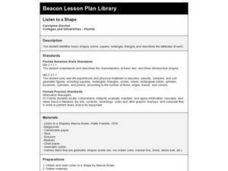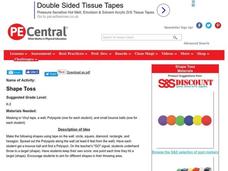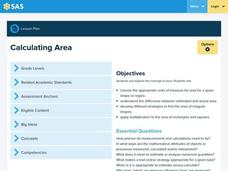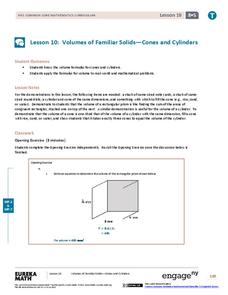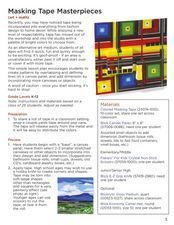Curated OER
The Chicken Run
Fourth graders work in a group of 4 to make rectangle with a 12m length of string. They discuss its perimeter and how they would calculate its area. Then another group of 4 make another rectangle and estimate if the area would be greater...
Curated OER
Perimeter Play
Fifth graders identify that the perimeter of a shape is the sum of its sides.
Students cut some string or rope to make the sides of a rectangle. Students write the measurement of the length of the rectangle and the measurement of the...
Curated OER
Rings and Diamonds
Fifth graders solve a problem by using systematic problem solving strategies. They determine if there is enough information to solve the problem. They solve a problem involving geometric shapes and area.
Curated OER
Listen to a Shape
First graders identify basic shapes (circle, square, rectangle, triangle) and describes the attributes of each. They use magazines to find examples of each shape, and then make a collage.
Curated OER
Measurement: Lesson 2
Eighth graders complete math problems given in this lesson, where they find the perimeter and area of specific figures. They estimate the perimeter and area of shapes and figures and then complete the mathematical formula to find the...
Curated OER
Shape Toss
Young scholars get a bounce ball and find a Polyspot. On the teacher's signal, students underhand throw to a target. They keep their own score: one point each time they hit a target.
Curated OER
Numerical Methods of Integration
Pupils review Riemann Sums with rectangles, used to approximate the area under a curve. They listen as the teacher introduces the Trapezoidal Rule to approximate the area under a curve. Students use Simpson's Rule to find the area under...
Pennsylvania Department of Education
Multiplication Using Arrays
Explore the concept of multiplication by using arrays. Classmates use arrays to gain a better understanding of multiplication. They break arrays apart to model the distributive property of multiplication over addition. The relationship...
Curated OER
What a Square
Students examine the painting "Old Man With A Gold Chain" by Rembrandt. They identify geometric shapes in the painting, measure these shapes and compare the relationships of these measurements.
Pennsylvania Department of Education
Making Cubes
Third graders explore vocabulary associated with three dimensional figures. In this transformations lesson, 3rd graders create two dimensional nets for three dimensional figures. Students become familiar with describing two...
Virginia Department of Education
Order Up!
Order in the math class! Scholars learn to evaluate expressions using the order of operations. A game has them rolling number cubes to determine numbers to use when evaluating.
Curated OER
Which container holds a larger amount of popcorn?
What does popcorn have to do with math? Seventh grade mathematicians are provided an opportunity to develop a conceptual understanding of the formula for volume and to use it as a tool to solve problems. The lesson begins with a...
Curated OER
Multiplying Polynomials
Students explore the concept of multiplying polynomials. In this multiplying polynomials lesson, students watch a video clip about basic math skills. Students work in groups on an exploration about why a binomial squared equals a perfect...
West Contra Costa Unified School District
Solving and Using Literal Equations
You literally need to use the resource. Young mathematicians solve geometric problems by using literal equations. They go on to solve distance/rate/time problems by using literal equations — a great progression that helps introduce the...
Illustrative Mathematics
Shape Hunt Part 2
Shapes are everywhere in the world around us, from rectangular doors to the circular wheels of a car. The second lesson in this series opens the eyes of young mathematicians to this wonderful world of shapes as they search the classroom,...
Curated OER
Solving Applications Using Quadratic Equations
In this solving applications worksheet, learners translate word problems to number sentences. They solve the created quadratic equation. This three-page worksheet contains 12 problems.
EngageNY
Multiplying Polynomials
There's only one way to multiply, right? Not when it comes to polynomials. Reach each individual by incorporating various representations to multiplying polynomials. This lesson approaches multiplying polynomials from all angles. Build...
Curated OER
Pythagorean Theorem by Graphic Manipulation
There are many different ways to show a proof of the Pythagorean Theorem. Here is a nice hands-on paper cutting activity that shows a graphic representation. You can even challenge your young Pythagoreans to come up with their own...
Illustrative Mathematics
Toilet Roll
Potty humor is always a big hit with the school-age crowd, and potty algebra takes this topic to a whole new level. Here the class develops a model that connects the dimensions (radii, paper thickness, and length of paper) of a...
West Contra Costa Unified School District
Square and Square Roots
Root for your pupils to learn about roots. Young mathematicians first review the meaning of squares and square roots. They then use this knowledge to simplify square roots of monomials with variables.
Virginia Department of Education
Volume of a Rectangular Prism
Fill the minds of your young mathematicians. A hands-on activity has learners fill in a rectangular prism with unit cubes to determine its volume. the exercise provides a great hands-on way for learners to connect the activity...
Curated OER
Number Addition Race
Practice basic addition facts and measuring skills. In this addition and measurement lesson, young scholars are provided with drywall tape and work in groups of four at a long table. Partners take turns generating addends and marking the...
EngageNY
Volumes of Familiar Solids – Cones and Cylinders
Investigate the volume of cones and cylinders. Scholars develop formulas for the volume of cones and cylinders in the 10th lesson plan of the module. They then use their formulas to calculate volume.
Curated OER
Masking Tape Masterpieces
Learners create non-objective art based on the design elements of line, color, balance and movement using tape. This simple lesson plan encourages students to create patterns by overlapping and defining lines on a canvas panel. One of...



